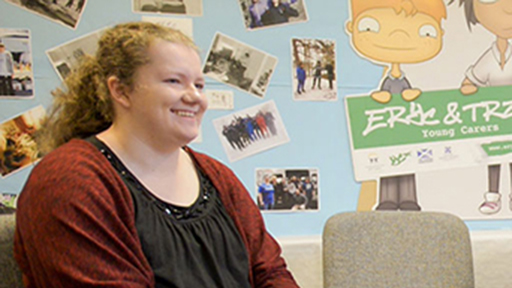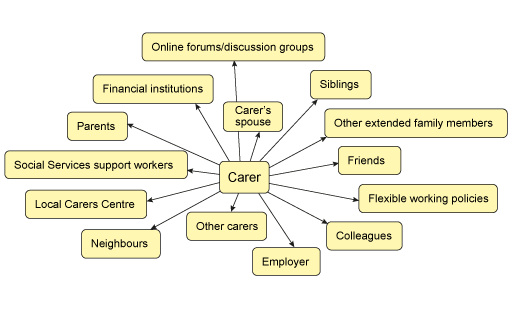Use 'Print preview' to check the number of pages and printer settings.
Print functionality varies between browsers.
Printable page generated Thursday, 27 November 2025, 10:46 AM
Session 4: Supporting carers in the workforce
Introduction

Carers and carers’ organisations tell us that there are different reasons why carers choose to return to work. A change in circumstances may mean that the time is now right for them to think about returning to work.
This could involve building on the knowledge and skills they have gained from caring to pursue care-related employment, such as health, social care or social work. They may return to their previous career, or their skills could be transferable to a completely different career.
This session draws on the experiences of individual carers to illustrate their motivations for returning to work, and how the skills they have gained are transferable to different roles. It will also explore the support available to carers returning to work, and specifically how you can support carers in your workforce.
Learning outcomes
After working through this session you will have:
a clearer understanding of the experiences of carers
an appreciation of the various skills, qualities and attributes that carers may develop and how some of these are transferable to work contexts
an understanding of carers’ motivations to return to work, or to balance paid employment with their caring role
an awareness of the factors that may help or hinder carers who are in paid employment, and the support available to them
an understanding of your role, and your organisation’s role, in supporting carers in your workforce.
Making my caring experience count
In this session we will meet Naomi who cares for her daughter. Naomi is considering returning to the workforce. You will explore her motivations for returning to work and how the skills she has gained from her caring role are transferable to employment.
Naomi

Naomi is 24 and a single parent. She left school at 15 with no qualifications and before having her daughter she worked in call centres. Her daughter, who has just started school, is visually impaired because she has albinism. Caring for her daughter has changed Naomi’s ambitions and she has decided she would like to develop a career in social work.
These are the steps Naomi has taken from making that decision to starting to gain experience and qualifications that will lead her towards achieving that goal.
- Naomi decided she wanted to get qualifications to give her daughter a better life. Her daughter inspired her to get started. She decided she wanted to do something in social care.
- As she needed qualifications and experience, Naomi looked into volunteering and studying.
- She has good support from her mum and her gran, and her brother suggested she try The Open University.
- Naomi heard about an advert for a Children’s Hearing Panel member, applied and was accepted. This experience gave her an insight into social work, which she would like to pursue as a career.
- She started the health and social care course with The Open University. She would prefer to be in college with more face-to-face learning but knows she’d be financially worse off doing that.
- Naomi has applied to do further voluntary work to support parents, giving her even more insight into the kind of work undertaken by social workers.
Naomi has started K101 An Introduction to Health & Social Care, which is an overview of health and social care and an introduction to learning in higher education.
She is also studying KYJ113 Foundations for Social Work Practice – a key introductory level 1 Open University course that develops knowledge of the key roles of social work and introduces the social work standards and codes of practice relevant to each UK nation.
Thinking about transferable skills

Naomi is working towards a career in social work. The following is a list of the skills, qualities and attributes that a social worker would need:
- excellent communication and people skills
- the ability to relate to people of all ages and backgrounds and gain their trust
- a practical and flexible approach to work
- tact, patience and empathy
- an understanding of the needs of different client groups
- a non-judgemental attitude
- the ability to work in a team and also use their own initiative
- the ability to assess situations and take appropriate action
- resilience – for coping with difficult situations and challenging cases
- good time management and organisational skills
- computer literacy and administrative skills.
Activity 4.1 Reflection on carers’ skills, qualities and attributes developed through their caring role
Think about the following question and make some notes in your notebook or Reflection Log.
- Looking at the skills, qualities and attributes above, how might Naomi’s caring experience prepare her to become a social worker?
Go to Activity 4.1 in your Reflection Log. Once you have completed the activity make sure you save the document again. Alternatively, you can use this document but don’t forget to save it.
If you are doing this course as part of a group or with a mentor then you can share your answers and discuss your notes with others.
Returning to work
Drawing on Katrina’s experience of returning to a career in nursing you will explore the skills, qualities and attributes carers can bring to the workplace.
Katrina
Katrina, 49, is married and has five children, two of whom live at home. One of her sons has autism and attention deficit disorder. As her sons got older Katrina found she had more time for herself and knew she wanted to do something but wasn’t sure what. She took up an Open University access course, which she passed. This gave her the confidence to take a Return to Nursing Practice course at university, something she’d been thinking about for ten years but didn’t think she’d ever manage to do. Two years on, she was working as a support worker in her local mental health unit waiting for her nursing registration to come through so that she could apply for a job as a staff nurse.
Listen to Katrina talking about her return to nursing.

Transcript
While caring for her son during his childhood it just wasn’t possible for Katrina to study or to think about returning to work full time. However, she did manage a few different jobs while caring. As her son grew up it was possible for her to think about returning to work, but she didn’t know where to start. There didn’t seem to be too many jobs around. But when she heard about Open University courses that were free to carers, she was able to recognise the opportunity they offered.
These are the steps Katrina took to get back to her nursing career.
- Doing some part-time work fostering other children and working as a childminder while still caring for her son.
- Her local Carers Centre told her she could study for free with The Open University because she was a carer, so she decided to take the plunge.
- Katrina started studying with a group of other carers as part of a collaborative initiative between the carers centre and The Open University.
- Succeeding with this course then gave her the confidence and impetus to plan her next steps and think about returning to work.
- With the support of the carers centre, Katrina looked into how she could return to nursing, having gained the confidence to do a Return to Nursing Practice course.
- She subsequently started working in a mental health unit.
Katrina completed Y177 Understanding Society (a former OU access module that has been replaced by the Y032 People, Work and Society access course) and a reflection course. These gave her the confidence to do a Return to Nursing Practice course.
Katrina has now received her registration documents and is working as a staff nurse in her local hospital. She continues to care for her son.
Activity 4.2 Looking at person specifications
Bearing in mind what you have learned about the carers and their experiences in a caring role we would now like you to consider what carers may bring to your organisation.
- Identify a person specification for a job in your organisation.
- Explore the information in the person specification, so that you are able to respond to the following questions:
- What knowledge, skills, qualities and attributes are required in the person specification?
- What might someone with experience of caring bring to the role?
- What kinds of question could an interview panel ask to identify some of these things during recruitment?
Go to Activity 4.2 in your Reflection Log. Once you have completed the activity, make sure you save the document again.
You can complete this activity on your own or in pairs if you are in a group. Remember to save your answers because you will return to these in future activities.
You can use your Reflection Log to record what you’ve found out or use this table. Whichever you use, remember to save the document.
If you completed this activity in pairs or in a group environment, you may want to discuss your answers.
Support for carers
So far you have thought about the skills, qualities and attributes carers can develop as part of their caring role. You may manage a carer who is returning to paid employment or someone who has been combining their work and caring roles. Now you will look at the support available for carers in the workplace and in the wider community.
For some carers, support might mean joining a carers group. For example, the young adult carers in Renfrewshire have a social group that meets fortnightly. They take part in a range of activities, learning together and supporting each other in their caring roles. Joining a support group may just be about having fun with people who understand the challenges in carers’ lives.
Clair, a young adult carer in Renfrewshire, comments about what she gains from being part of the young adult carers group.
Everyone needs a break from their emotions, you know, just to kind of sit and have a laugh and a chat with someone, get it all out, you know.
Listen to young adult carers Clair, Jade and Scott talking about how they support each other.

Transcript
Group discussion
Support within the workplace
The following two case studies show how support within the workplace can make all the difference to employees who have a caring role.
Michael

Michael is 49 and a skilled mechanical engineer. He has worked for the same Aberdeen-based construction company for the last 20 years. For the past four years Michael has been caring for his wife Linda, who was diagnosed with multiple sclerosis in her early 40s. As Linda’s condition became more serious and she required more care, Michael found that coping with the household duties and caring for Linda, as well as fulfilling his role at work, was becoming increasingly challenging.
For a while Michael didn’t want to raise the issue at work and continued to juggle his responsibilities without asking for any kind of support or speaking to anyone about the impact that caring was having on him. He didn’t actually think of himself as a carer – he ‘was just helping to look after his wife – as anyone would do’. He found it a very stressful and tiring time but continued to work as normal, and if he ever needed to take Linda to hospital or for an appointment, he would use annual leave to take a morning or an afternoon off work, but also worried about doing this, especially if it was at short notice.
Michael is part of a small team of highly skilled and experienced engineers, each with an important part to play in the company. Sometimes he and his colleagues are required to travel beyond Aberdeen to work on site at developments across the North East of Scotland, if necessary including overnight stays. Eventually, Michael felt he had to speak to his senior manager about the impact his caring role was having on him and his ability to continue in his current role at work. His manager and colleagues knew Michael’s wife was unwell, and although they saw he was clearly tired, had assumed he was coping and everything was under control.
After a discussion with his line manager, Michael and his colleagues were asked to a team meeting to talk about how best Michael could be supported to balance his work and caring responsibilities. The company was keen to retain a valuable member of staff and wanted to ensure that the team was involved in any decisions around this.
The company didn’t have any formal flexible working policies in place but were happy to accommodate any times when Michael might need to alter his hours to come in or leave a bit earlier or later if necessary. They also assured him that he’d be able to take time off for hospital appointments or emergency situations. The team were similarly happy to support Michael as a colleague and have agreed an arrangement that means he does not have to work away from home.
Being able to work more flexibly has been a tremendous help to Michael who, as a result, feels less stressed and more able to cope. Equally important is knowing that the company understands about his caring situation and supports him.
Recognising that Michael’s situation may be one that others in the organisation could experience, the company is now looking at how it can develop its support to carers in the workforce:
Realising that we could potentially lose Michael was a bit of a wake-up call and has really made us think about how important the health and well-being of our employees is to the company as a whole.
Veronica

Veronica is 55 and has been caring for her husband, who has a long-term condition, for nearly 25 years. At first she didn’t realise she was a carer and was working in a senior nursing role, managing full-time work and three young children alongside her caring role. She went down to part-time hours and gave up her senior post. Giving up work was not an option as she was the main breadwinner for the family. As the kids got older she got the opportunity of a promotion and started progressing her career again. She developed coping strategies for managing lack of sleep and other impacts of caring. Veronica never took leave as a result of her caring role, and she feels she probably overcompensated so there would be no impact on her work. She reckons her experience managing her caring and working roles has made her more resilient.
While in a subsequent full-time post, her parents’ health began to deteriorate and Veronica recognised they needed additional support. She took on this responsibility ‘automatically’ as she was the closest family member and had experience of caring both at home and at work. This time she reduced her work hours with full support from her employer, who had an understanding of carers’ issues. She feels very supported in her current NHS role, which accommodates flexible working. Veronica can work from home when needed and at times that suit her, even if this is in the evening. It means she is better able to manage her increased caring role, particularly around emergencies.
Having a career is important to Veronica and she feels that if/when her caring role ends she still wants to be part of the workforce and society. It’s important for her self-esteem, as well as for financial reasons. It has made a huge difference working in a carer-aware workplace and Veronica now realises how much stress she had been under earlier in her career and how it would have made a difference to her to have support at work.
I really wished I could have explained my situation to someone then. The difference between then and now, working in a carer-supportive environment, is day and night.
Factors that might help or hinder carers
Table 4.1 sets out a range of positive factors and possible difficulties that carers might face when returning to work or balancing employment with their caring role.
| Positive factors | Possible difficulties |
|---|---|
| More time available | Lack of time |
| Good health | Poor mental health, poor physical health |
| Communication skills | Unpredictability of caring role |
| Flexible | No childcare |
| Resilience | Lack of confidence |
| Adaptability | Lack of transport |
| Knowing what I want to do | I don’t know what I want to do |
| Maturity | No space to study |
| Ability to manage and juggle different activities | Financial worries |
| Supportive employer | Inflexible employer |
| Open to try new things | Don’t know where to go for help |
| Good support network | Lack of support networks – family live far away |
Activity 4.3 Factors that help or hinder carers
Thinking of the carers you have met during the course, or carers that you know or support at work, think about some of the factors that may help or hinder them. Note your thoughts in your notebook or Reflection Log.
Go to Activity 4.3 in your Reflection Log. Once you have completed the activity make sure you save the document again. Alternatively, you can use this document but don’t forget to save it.
If you are doing this course as part of a group or with a mentor then you can share your answers and discuss your notes with others.
A carer’s support network
You have just reflected on factors that might help or hinder carers. Now it’s time to think about the support network that is available to them. We all need some help to get to where we want to be in life. This can come from a range of sources, both in work and outside work.
In your organisation, think about the support available for carers. This could include:
- supportive policies
- flexible working options
- support and supervision
- information on the staff intranet
- a carers’ group.
Outside work, who could help to support carers to manage their caring role:
- family members?
- friends?
- peer support from fellow carers?
- local carers centre?
- other organisations or activities?
Look at the spider diagram in Figure 4.6. This shows a range of possible supports a carer might have.
A culture of support
This case study might help you to think about the steps you could take to develop support for carers within your own organisation.
Exemplar organisation case study
The Scottish Court Service (SCS) has developed and embedded a culture of support for carers working within the organisation.
In 2001 SCS formed an internal working group of staff with significant caring responsibilities to look at the demand for additional support for carers within SCS, and to develop best practice among UK employers in supporting carer employees.
Since this time SCS has progressed a number of elements to support staff who have caring responsibilities. This demonstrates commitment to carers in the organisation and reflects a positive approach to overall carer well-being.
Key elements of this support include:
1. Identification of carers
Carers within SCS can apply to be included on a ‘Carer Register’: 14% of SCS staff are currently on this register. Apart from being able to access particular benefits, this means that if a member of staff moves to a new department, the new line manager will be aware of their caring responsibilities.
2. Policy
SCS has a standalone carer policy which includes a clear definition of a carer and what carers should expect from the SCS. This includes provision for paid compassionate carer leave. Other relevant policies, such as part-time working and flexible hours, also enable carers to benefit from working hours which suit their caring situation.
3. Practical support
Joining the carer register brings benefits such as financial support for respite care; interest-free loans to purchase specialist equipment; and paid special leave for caring commitments. Staff can also access a free confidential Employee Assistance Programme (EAP), which provides advice and support on a wide range of issues relevant to carers, such as legal and financial, as well as provision of counselling where appropriate.
4. Communication and awareness raising
All relevant policies and supports are communicated extensively to staff via a number of mechanisms, including the SCS intranet, staff handbook, staff circular, posters, and both internal and external booklets (including one for prospective applicants). These help to promote awareness of the carer policy and register, which are also covered in training for line managers. The carer intranet page also includes useful links to external organisations that carers across the SCS may find useful.
5. Peer support
SCS has a Carer Contact Team which provides valuable support to staff, giving carers the opportunity to speak to someone about their caring responsibilities and acting as a stepping stone between staff and management or HR as appropriate. Each member of the carer contact team brings the knowledge and experience of caring for someone at one point in their lives.
The team also organises a Carer Conference every two years, which all staff on the carer register are invited to, along with the person they care for. These are introduced by the head of the SCS and include sessions on depression, manual handling, the EAP and stress management. Suggestions are also sought from carers on how support can be improved. As an outcome of suggestions at a previous conference for example, SCS staff can now access the provision of free Powers of Attorney.
The contact team was also instrumental in producing a DVD promoting carers in the SCS. This features an introduction from the Chief Executive, presentations from the Director of HR, the chair of the trade union and a carer, and portrays a work-based scenario featuring a typical conversation between a carer and his/her manager. Copies of the DVD were circulated to all senior managers and can be viewed on the SCS carer intranet page.
What is clear from the SCS example is the level of commitment from the most senior tier of management, helping to embed this culture of support across all levels of the organisation. This is also demonstrated in the fact that carers themselves are central in the development and improvement of policies and supports.
While the SCS provides exemplar support for staff who are carers, it is important to remember that this has been developed over 13 years, and is likely to exceed what many organisations could reasonably put in place within a short timescale. However, it demonstrates what can be achieved in the longer term and provides some examples of the type of support that can make a real difference to employees with caring responsibilities.
Activity 4.4 Support network
Try drawing your own spider diagram to illustrate the support for carers you are aware of in your workplace.
Using a different colour pen, add other sources of support for carers that you have explored during the session.
Considering the example of the Scottish Court Service, and any ideas you may have, use another colour to add support that your organisation could possibly provide for carers in the future.
If you are working in a group, you can share your spider diagram with the rest of the group and discuss each other’s ideas before adding them to the diagram.
You can use the online tool www.bubbl.us to create your spider diagram or you can do this with pen and paper if you prefer.
Before drawing your spider diagram, here are some points to consider:
- What skills and qualities should a supportive line manager have? (such as tact, sensitivity, empathy, ability to build mutual trust and respect, communication skills, fairness, reflective)
- What factors might you need to consider when supporting a carer in your workforce (such as impact on the rest of the team, workload, staff awareness, supportive culture, policies)?
Keep in mind that you should gain permission from staff before sharing information about their caring role with the rest of the team. Respect their privacy.
- What other support could be put in place for carers in your workplace?
Go to Activity 4.4 of your Reflection Log. Once you have completed the activity, make sure you save the document again. Alternatively, use this document we have provided.
Be sure to save the spider diagram as this could help you with your planning activity in the next session.
Summary
You have now completed Session 4. This session focused on how the skills, qualities and attributes a carer may gain from their caring role can be transferable to paid employment, while acknowledging that carers may need support. You have looked at the factors that may help or hinder carers and how you can support carers in your workforce to balance their work and caring role.
You can explore the support available to carers in the wider community by searching online or you can get advice from some of the organisations listed under Websites in the Resources section. Many of the carers who have contributed to this course have found the support of other carers vital.
You have almost finished the course! The next session looks at setting personal and organisational goals to become Carer Positive and the steps you are going to take to achieve this.
Quiz
To conclude this part of the course and consolidate your learning you may like to complete the fourth quiz.
Quiz 4 provides evidence that you are achieving the following learning outcomes:
- an understanding of carers’ motivations to return to work, or to balance paid employment with their caring role
- an appreciation of the various skills, qualities and attributes that carers may develop and how some of these are transferable to work contexts
- an awareness of the factors that may help or hinder carers who are in paid employment, and the support available to them
- an understanding of your role, and your organisation’s role, in supporting carers in your workforce.
If you need a reminder about the quizzes and the criteria for getting a badge, visit How to complete the course quizzes.
References
Acknowledgements
Caring Counts: a reflection and planning course for carers was written by Lindsay Hewitt and Sarah Burton, quizzes by Julie Robson, The Open University.
This course was redeveloped to create Caring_Counts_in_the_Workplace in collaboration with Gill Ryan from NHS Education for Scotland and the Scottish Social Services Council’s Equal Partners in Care project, together with Sue McLintock (Carers Scotland) from the Scottish Government’s Carer Positive kitemark project.
Except for third party materials and otherwise stated (see terms and conditions), this content is made available under a Creative Commons Attribution-NonCommercial-ShareAlike 4.0 Licence.
The material acknowledged below is Proprietary and used under licence (not subject to Creative Commons Licence). Grateful acknowledgement is made to the following sources for permission to reproduce material in this unit:
Images
Figure 4.1: alexsl/iStockphoto.com
Figure 4.2: © The Open University/Library image (model image only)
Figure 4.3: © fotosearch.com
Figure 4.4: Richard Learoyd for © The Open University/Library image (model image only)
Figure 4.5: Richard Learoyd for © The Open University/Library image (model image only)
Video
Video: © The Open University
Every effort has been made to contact copyright owners. If any have been inadvertently overlooked, the publishers will be pleased to make the necessary arrangements at the first opportunity.
Don’t miss out:
1. Join over 200,000 students, currently studying with The Open University – http://www.open.ac.uk/ choose/ ou/ open-content
2. Enjoyed this? Find out more about this topic or browse all our free course materials on OpenLearn – http://www.open.edu/ openlearn/
3. Outside the UK? We have students in over a hundred countries studying online qualifications – http://www.openuniversity.edu/ – including an MBA at our triple accredited Business School.
4. Carer Positive Find out more about the kitemark for employers http://www.carerpositive.org/
5. Equal Partners in Care Find out more about the Scottish framework for learning and practice with carers and young carers www.knowledge.scot.nhs.uk/ equalpartnersincare or www.ssks.org.uk/ equalpartnersincare
